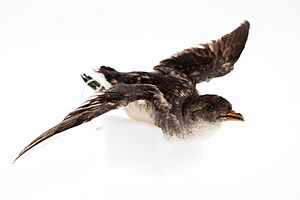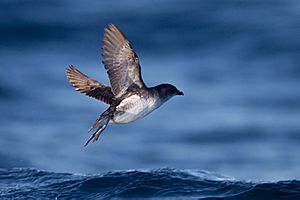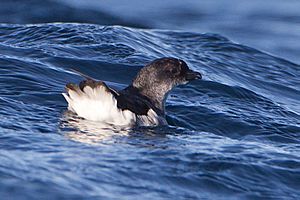Common diving petrel facts for kids
Quick facts for kids Common diving petrel |
|
|---|---|
 |
|
| Nominate adult Pelecanoides urinatrix specimen. | |
| Conservation status | |
| Scientific classification | |
| Genus: |
Pelecanoides
|
| Species: |
urinatrix
|
The Common diving-petrel (Pelecanoides urinatrix) is a small seabird. It is also called the smaller diving-petrel or just the diving-petrel. This bird is one of five similar small petrels found in the southern oceans. It looks a bit like an auk.
Common diving-petrels live on islands in the South Atlantic Ocean. They are also found on islands in the southern Indian Ocean, near New Zealand, and off southeastern Australia.
About Its Name
The Common diving-petrel was first described in 1789 by a German naturalist named Johann Friedrich Gmelin.
Its scientific name, Pelecanoides urinatrix, has a special meaning. Pelecanoides means "Pelican-resembling." This name was given because diving-petrels have throat pouches. They use these pouches to carry food, much like a pelican. The second part, urinatrix, comes from a Latin word meaning "diver."
The names of its different types (subspecies) also have meanings:
- chathamensis refers to the Chatham Islands.
- exsul means "isolated" or "remote."
- dacunhae refers to the Tristan da Cunha Islands.
- berard honors a French explorer named Auguste Bérard.
- coppingeri honors a Royal Navy surgeon and naturalist named Richard William Coppinger.
There are six known types, or subspecies, of the Common diving-petrel. They are slightly different in size, especially their bills.
- P. u. urinatrix: Found in Australia, Tasmania, and the North Island, New Zealand.
- P. u. chathamensis: Lives on Stewart, Snares, and Chatham Islands in New Zealand.
- P. u. exsul: Found on South Georgia and other subantarctic islands. These include the Kerguelen, Heard and McDonald islands, and New Zealand's Auckland Islands, Antipodes Island, and Campbell Island.
- P. u. dacunhae: Lives on the Tristan da Cunha islands and Gough Island.
- P. u. berard: Found in the Falkland Islands and across the Southwest Atlantic Ocean.
- P. u. coppingeri: Its exact home is not fully known. It might breed in Southern Chile.
What It Looks Like
The Common diving-petrel is a small, round bird. It is about 20 to 25 centimeters (8 to 10 inches) long. It weighs around 86 to 186 grams (3 to 6.5 ounces).
Its feathers are black on top and dull white underneath. It has a short, black bill. Its wings have thin white stripes. The face and neck can look more brown than black. Its legs and feet are blue with dark brown webbing between the toes.
It looks very similar to the South Georgia diving petrel. But the Common diving-petrel has brown inner feathers on its wings. The South Georgia petrel has lighter inner feathers. Common petrels also have smaller, narrower bills. Another difference is that the South Georgia diving petrel has a black line down the back of its legs. The Common species is also a little bit bigger.
Where It Lives
Common diving-petrels are found between 35 and 55 degrees south of the equator. They mostly live around islands. Their population is slowly decreasing, but not so fast that it is a big worry.
These birds dig burrows (tunnels) about 1.5 meters (5 feet) deep. They usually build them on grassy slopes. Sometimes, they make their homes on flat land too.
How It Behaves
Common diving-petrels hunt for food near the coast during breeding season. We don't know much about where they go when they are not breeding.
Like other birds in their family, they dive into the water to catch food. They use their wings to swim underwater. They can dive as deep as 60 meters (200 feet)! Their diet is mostly made up of small sea creatures called crustaceans. They sometimes hunt at night for tiny animals that move up and down in the water.
Most of their feeding happens in the ocean close to shore. But sometimes they go into deeper ocean areas when they are not breeding. This non-breeding time is only about two months a year.
Common diving-petrels usually stay with one partner for life. They form large breeding groups, with about one nest per square meter. Their nests are burrows about 50 centimeters (20 inches) long. At the end of the burrow, there is a chamber. This chamber might be lined with dried grass.
The female bird lays one white egg. The egg is about 38 by 29 millimeters (1.5 by 1.1 inches). Both parents take turns sitting on the egg for 53 to 55 days. When the chicks hatch, they are grey and fuzzy. The parents care for them for 10 to 15 days. The young birds are ready to fly after 45 to 59 days. Common diving-petrels usually live for about 6.5 years.
Images for kids
See also
 In Spanish: Potoyunco común para niños
In Spanish: Potoyunco común para niños






